Hong Kongers are finding inventive ways to grow sweet potatoes, mangoes, and other edible goodies in an urban jungle.
HONG KONG—
It’s not easy to find the Mango King. “Do you want to go the safe way? Or the quick way?” asks Michael Leung, a designer and urban farming advocate, as we walk past the wholesale fruit market in Hong Kong’s Yau Ma Tei district, halfway up the Kowloon Peninsula. We opt for the quick way, which takes us through a tangled web of highway off-ramps and access roads. Two decades ago, this area was open water, but land reclamation and infrastructure works have turned it into an uninviting no man’s land next to one of Hong Kong’s most crowded neighborhoods.
Somewhere in this mess of traffic is a leftover patch of land that has been turned into an illegal farm.
“We call him the Mango King because he loves mangoes so much,” Leung says after we dodge an oncoming taxi. The Mango King is one of a growing number of urban farmers in Hong Kong, maximizing the city’s tight spaces to produce his own food. He currently grows sweet potatoes, 45 papaya trees, five mango trees, three banana trees, and two lychee trees on 700 square feet of land.
Hong Kong is one of the world’s most densely populated cities, famous for its skyscraper canyons and gritty, neon-lit streets. But most of its 1,100-square-kilometer territory is actually undeveloped—country parks alone account for more than half of the city’s land area. Instead of fostering a close connection between city-dwellers and nature, though, the opposite has happened: Hong Kong today is a city largely devoid of greenery, despite being surrounded by a spectacular procession of green mountains and craggy shorelines.

The city’s disconnect with nature has broad implications. In the early 1990s, a full third of Hong Kong’s fruits and vegetables were produced locally in the New Territories, the hinterland that stretches from urban Kowloon to the border with mainland China. Today, that number has plummeted to 2.3 percent, with nearly everything imported from the mainland and beyond: apples from the United States, kiwis from Italy, oranges from South Africa. Recent years have seen a resurgence of interest in local organic agriculture among young people born in the 1980s and ’90s, but with a steady supply of cheap, imported produce arriving daily in Hong Kong’s port, changing the attitudes of the broader populace isn’t easy.
That’s where Leung comes in. Born in London to Hong Konger parents, he moved to the city in 2009, when he was 26 years old, and has since embarked on a series of projects that combine art, design, community work, and urban agriculture. One of his most popular initiatives, HK Honey, connects local beekeepers with apartment dwellers who are eager to install beehives on their rooftops and balconies as an eco-friendly gesture (and to reap the benefits of delicious honey, no doubt). He’s currently focused on HK Farm, a network of rooftop gardens around Yau Ma Tei, one of Hong Kong’s oldest neighborhoods and one that hasn’t seen much agricultural activity for the better part of a century.

“Growing food shouldn’t be exclusive to the New Territories—it should happen in the urban area as well,” Leung says. “It encourages people to think about food origin, the use of public space, their neighborhood—there are many areas in Hong Kong that have no neighborhood spirit.”
In Yau Ma Tei, Leung has tapped into a small but passionate community of artists, activists, and longtime residents who are nurturing life from between the cracks of the concrete jungle.
The Mango King is a compact, middle-age man with graying hair, a weathered face, and well-worn jeans smeared with dirt. He lives in a lean-to under the shade of wispy horsetail trees, surrounded on all sides by speeding traffic. After ducking through a hole in a chain-link fence, we present him with a bag of ripe mangoes and he enthusiastically shows us around his farm.
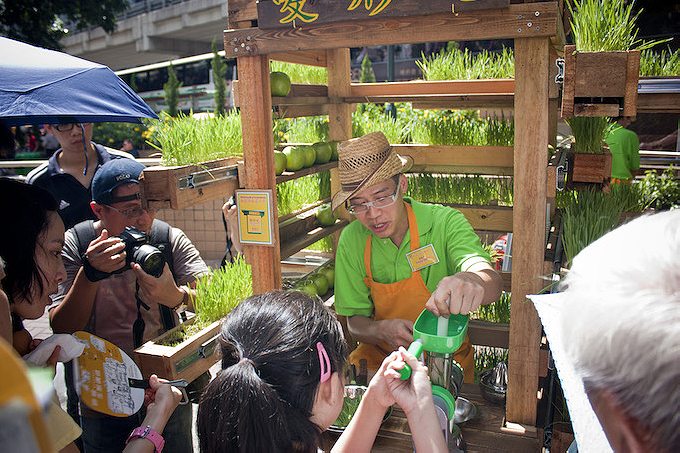
“Ten years—that’s the fastest a mango tree will grow from seed, if you want mangoes,” he says, showing us some tiny seedlings. “But if you use cuttings, it’s two years.” (Cuttings are cut portions of a plant that can be transplanted into soil.) Nearby, a few pineapple heads stick out of the ground, next to a large spread of sweet potato plants. “I’ve only been doing this for a year here, but there’s construction nearby and some surveyors told me they might kick me off this land,” he says. “But that wouldn’t be for at least half a year, and by then I’ll be harvesting.”
THE MANGO KING GROWS SWEET POTATOES, 45 PAPAYA TREES, FIVE MANGO TREES, THREE BANANA TREES, AND TWO LYCHEE TREES ON 700 SQUARE FEET
Cultivating food in the middle of a spaghetti junction is not an easy endeavor. There’s no running water, so the Mango King walks to a nearby shopping mall to fill up plastic jugs. And when he cooks, passing drivers are often alarmed by the smoke and call the fire department. For the most part, though, the authorities leave him alone.

I ask the Mango King why he started growing food—and why here of all places. He evades the question and instead talks about a memory from his youth. “Back in my village in China, I dabbled in farming with my friends—actually, it was more like I watched them grow things,” he says. “Growing things, it’s all about experience and how passionate you are. If you’re not into it, nothing will grow.” (Later, Leung tells me that the Mango King doesn’t like talking about his past or how he ended up on the street. “I think he’s had a rough life,” he says.)
Twenty minutes later, we arrive at So Boring, an informal pay-what-you-can coffee shop with folding tables set up on the sidewalk of Ferry Street. All the food here is locally grown and organic, and the café donates some of its waste—like pineapple heads—to the Mango King. We join a half-dozen staff and regulars sitting outside. Leung introduces me to Fredma, a 72-year-old woman with a commanding in presence. After I decline a dish of locally grown pumpkin curry—I’ve already eaten, I tell her—she insists. “Ho mei,” she says. “It’s delicious.” I relent, and she is right—sweet, earthy, and a bit spicy.
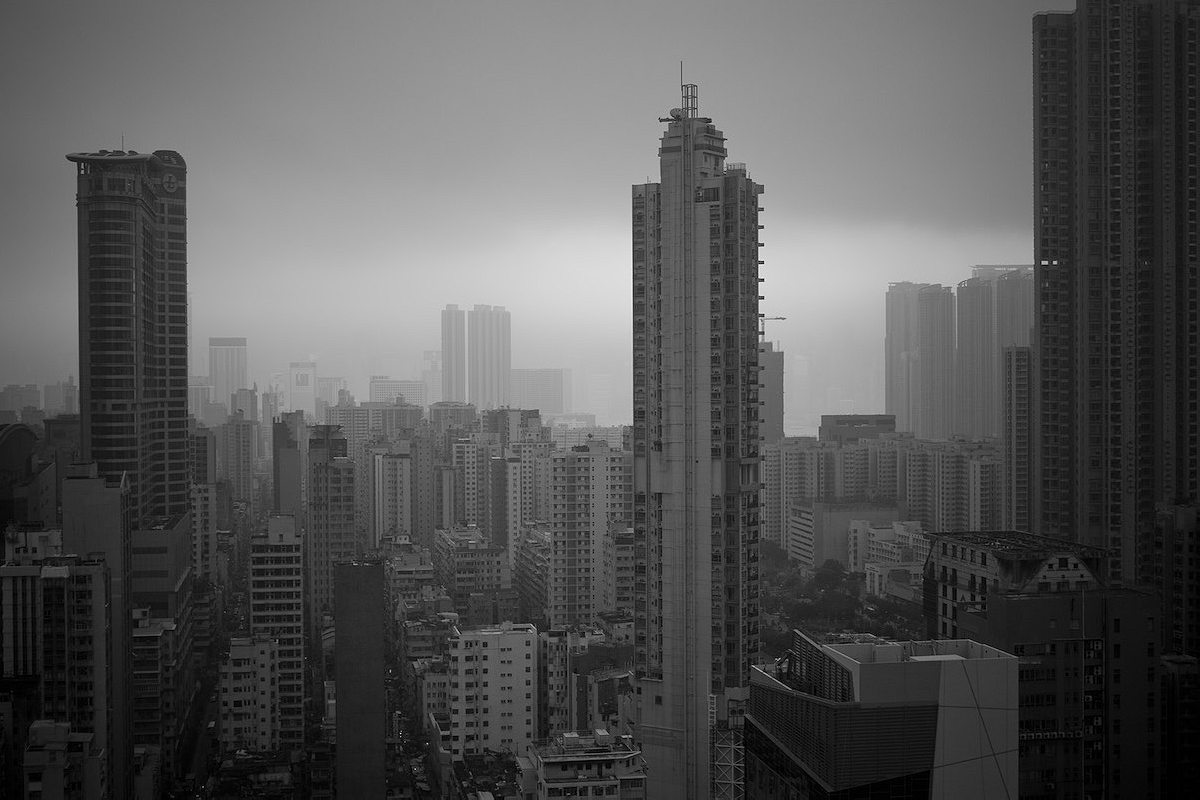
Leung and Fredma met through Wooferten, a group of artist-activists that run a community art space nearby. Fredma (so nicknamed because she has a son named Fred) shows up nearly every day and considers herself an urban agriculture enthusiast. Last year, Modern Farmer magazine featured her Typhoon Tea, which she created on a stormy day with peppermint, honey, and lime harvested from Leung’s roof.
In many ways, Fredma embodies what’s best about Hong Kong: a make-do attitude that can lead to brilliant, improvised responses to tough urban conditions. The same kind of ingenuity can be seen on Canton Road, where the owner of a Chinese medicine shop, Mr. Pang, has turned the street signpost outside his business into an ad hoc planter that now overflows with basil and other herbs.
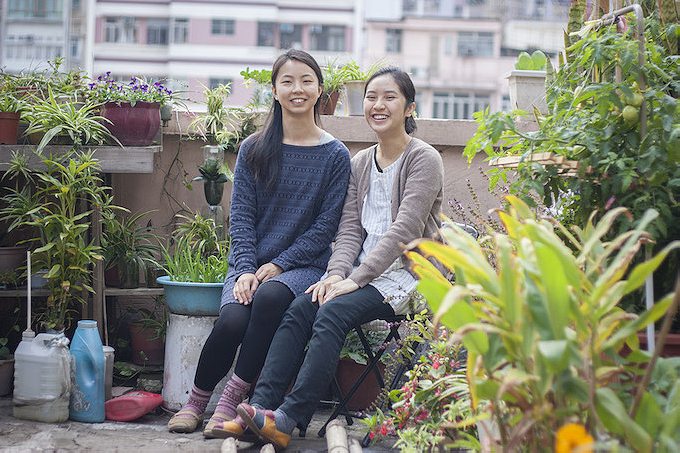
“I used to keep some plants on the pavement outside, but there wasn’t enough light, so they didn’t grow very well,” Pang says when I visit him one weekend afternoon. A middle-age man with taut, tanned skin, he sits behind a counter, jars of various herbs stacked on the wall behind him. “I noticed the sign and thought, ‘Why not hoist them up?’ It’s like having a sky garden.”
Inspired by Pang, Michael Leung and Wooferten have been making planters for street signs around the neighborhood, working with shops to decide what to grow and teaching them how to water the plants. Pang uses a makeshift device that consists of a plastic container attached to a long rod and a string that releases water when pulled. “They think they’re just growing stuff, but we see it as guerilla gardening in that they’re making use of vacant public space,” Leung says.
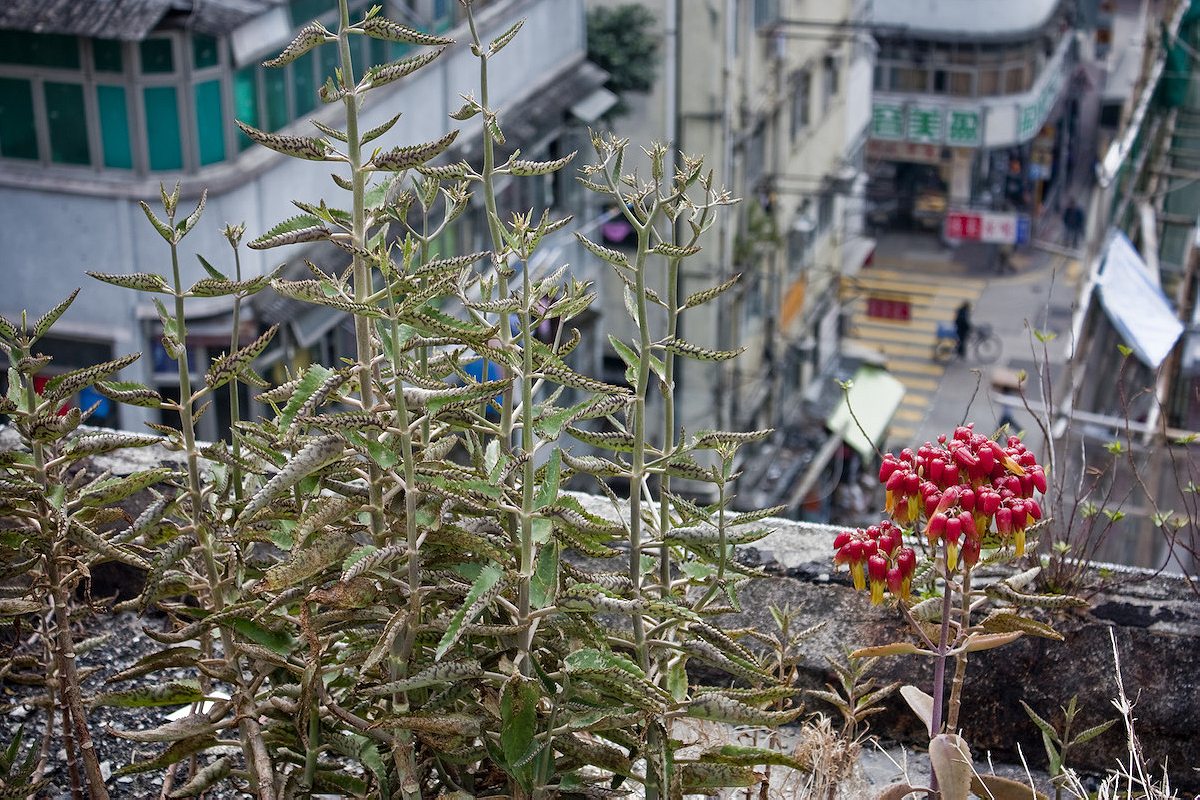
Neighbors seem fond of the idea. As I speak with Pang, a friend of his who’s been hanging around the shop chimes in. “He’s very creative!” the friend says, laughing. “They should give him a patent.” He turns to Pang. “Just watch out—the government will come catch you if the plants fall on somebody’s head.”
HONG KONG’S GOVERNMENT IS NO FRIEND OF GUERILLA GARDENING, RUNNING TELEVISION ADS AGAINST ILLEGAL PLANTING AND TEARING UP INFORMAL VEGETABLE PATCHES
He’s only half joking. Hong Kong’s government is no friend of guerilla gardening, running television ads against illegal planting and tearing up informal vegetable and herb patches that elderly people grow on vacant pieces of land, with the pretext that illegal gardening could attract mosquitoes and cause landslides in hilly areas. There aren’t many alternatives, either—there are just 22 government-run community gardens in Hong Kong’s public parks, and demand is so high that plots are rented out for only four months at a time. And though the government’s Greening Master Plan has made big strides to introduce more greenery to public spaces by planting shrubs, trees, and flowers along roadsides and in other concrete-heavy areas, it makes no allowance for productive gardens. “Basically, we adopt the ‘right species at the right place’ principle in selecting plant species,” a spokeswoman for the Civil Engineering and Development Department tells me when I ask why all this new greenery doesn’t include edible plants that people could harvest.
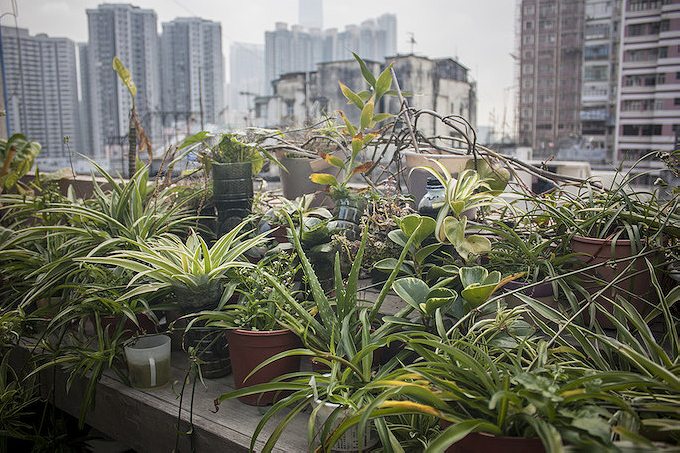
Meanwhile, the government has been actively thinning the number of fruit-bearing trees in parks and along streets, replacing them with lower-maintenance species, such as palms. “There used to be a papaya tree around the corner from here, but neighbors say it was cleared off,” says Sum Wing Man, a 28-year-old artist, when I meet her on the rooftop garden she helps maintain, a seventh-floor oasis surrounded by concrete apartment towers on all sides. “But even if there was fruit, you cannot eat it, because they spray everything with chemicals.”
Sum developed her green thumb after moving to a studio in the countryside. “I was not making any art—I just had a good life, cooking every meal, planting my own food,” she says. That led her to Mapopo Farm, an organic agricultural settlement active in Hong Kong’s local food movement, and from there she ended up working with Yau Ma Tei Gardener, a group that runs this rooftop farm.
Sum explains that the group began after its founder, artist Vangi Fong, rented a studio in a walkup apartment building on Shanghai Street and began growing vegetables on the roof. One day, Fong found a letter tucked into one of her plants. “It said, ‘We both like planting. Maybe we can be friends,’” says Sum. “It was signed, ‘Uncle Mui.’” Mui has lived downstairs for more than 40 years, but he never had an opportunity to put his green thumb to use, beyond maintaining a few potted plants. One thing led to another and soon about a dozen people were involved in running the garden and hosting workshops. “We made seed bombs”—a compressed bundle of soil containing seeds—“and threw them on buildings, in parks, on abandoned land,” Sum says. “We didn’t have much success. A lot of them were taken away by park cleaners.”
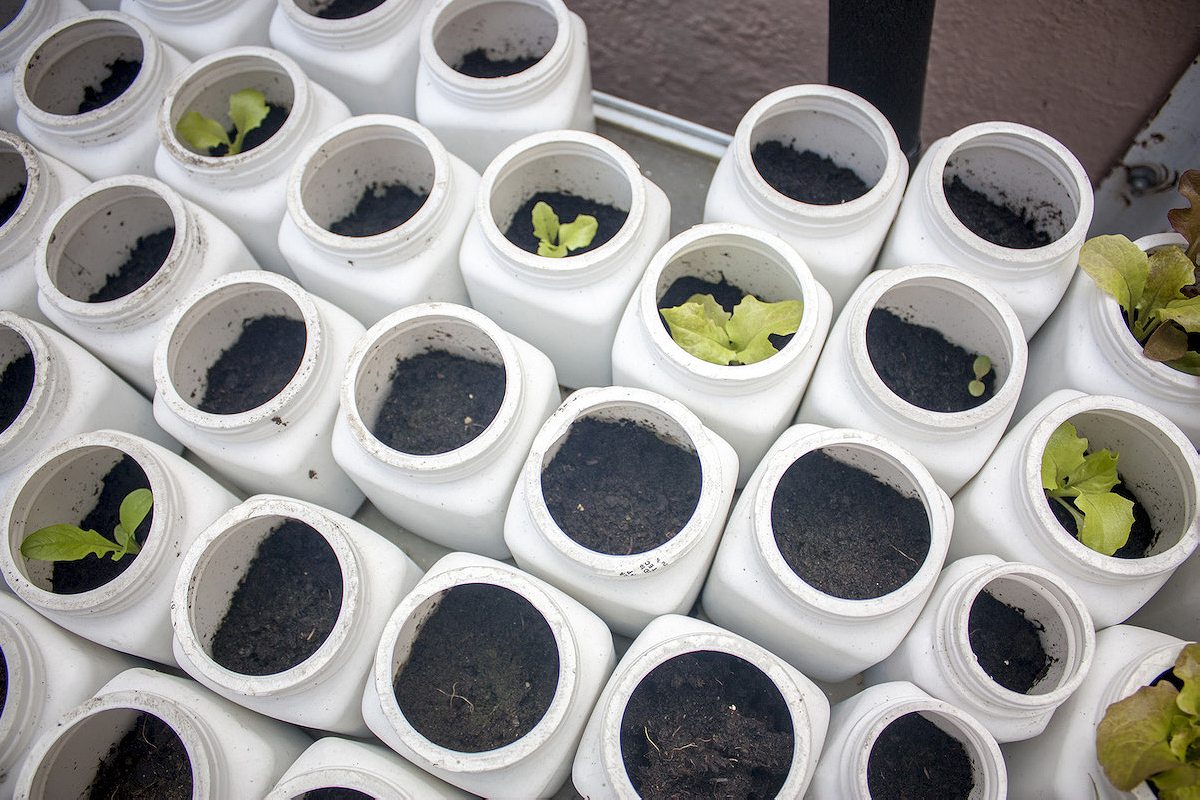
As we sit on the roof, another Yau Ma Tei gardener named Step Au joins us. She and Sum take me on a tour of the rooftop, where ginger, lemongrass, pineapples, and potatoes are growing in a variety of recycled plastic buckets, old wooden drawers, and small containers donated by a Chinese medicine shop.
I ask the pair why they dedicate their time to rooftop vegetable gardening and illicit seed bombing. “It’s about the right to public space,” Au says. “And I like that we’re not just planting for viewing—we’re planting to change what we eat. It’s a little contribution every day.”
As I leave the rooftop, I descend the narrow stairwell and hear violin notes coming from an elderly musicians’ association on the second floor. I turn right as I leave the building, and as I dodge pedestrians on Shanghai Street, I notice something growing inside one of the street signposts.
I walk closer and look up: chili peppers.
